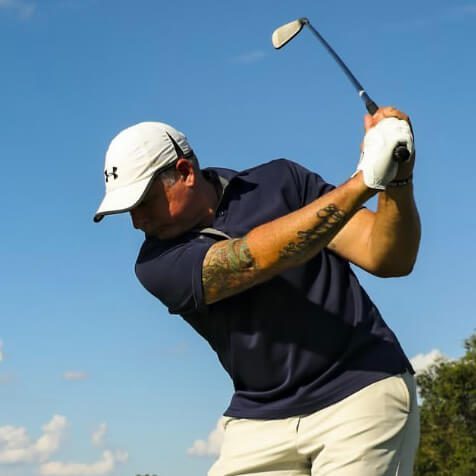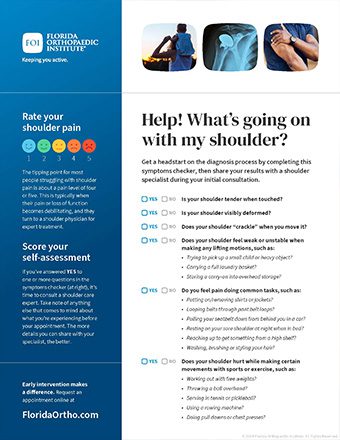12 common causes of upper arm shoulder pain

There’s a reason we say “shoulder the burden” instead of “elbow” or “knee” the burden. The shoulder works harder than any other part of the body, from heavy lifting to constant meticulous movements. Once you factor in sports, falls, accidents and chronic diseases, it’s easy to see why the shoulder is prone to experience a rotator cuff injury, tendinitis, or tear (all of which are common causes of upper arm shoulder pain.
Pain in the upper arm and shoulder affects 18% to 26% of adults, according to findings from the National Institute of Health’s population surveys. It’s common across all ages and activity levels. Athletes and computer users alike get rotator cuff tears. Age-related degeneration and wear and tear combine to make older adults susceptible to injuries. Some upper arm shoulder pain issues can cause further problems, like a domino effect.
The good news, however, is that many conditions that cause upper arm shoulder pain can be treated at home. In fact, only around 25% of patients who come to us with this type of joint pain require surgery to regain their range of motion and find pain relief.
Read on to learn about the 12 most common causes of upper arm shoulder pain and find out how to know when it’s time to see an orthopedic physician.
What are the most common causes of upper arm shoulder pain?
Rotator cuff tendonitis is the most common culprit of upper arm shoulder pain. Causes also include overuse, accidents and arthritis, and most overlap or interconnect. Sometimes, you can pinpoint a specific incident or activity after which your shoulder started to hurt. Other times, your upper arm shoulder pain may seemingly come out of nowhere.
Most pain in the upper arm or shoulder can be attributed to one of these three classifications of injuries, conditions or disorders.

Arthritis-related
- Osteoarthritis
- Rheumatoid arthritis
- Post-traumatic arthritis
Overuse-related
- AC joint injuries
- Bursitis or tendinitis
- Shoulder impingement
- Rotator cuff tears
- SLAP tears (or cartilage tears)
Trauma-related
- Dislocations
- Instability
- Fractures
- Separations
Arthritis that can result in upper arm shoulder pain
The shoulder can be affected by osteoarthritis, rheumatoid arthritis, or post-traumatic arthritis, all of which can cause ongoing shoulder and upper arm joint pain and stiffness.
Osteoarthritis
This is the most common form of arthritis, associated with wear and tear. It’s often asymptomatic in the shoulder joint.
Rheumatoid arthritis
Rheumatoid arthritis is an autoimmune disease that attacks joints throughout the body. In the upper limbs, it can produce symmetrical arm shoulder pain—left and right sides both affected, not just one.
Post-traumatic arthritis
Posttraumatic arthritis develops after an acute injury, such as an accident or fall.
Shoulder pain conditions connected to overuse
Placing repetitive stress on your shoulder joint is easy to do through work and sports. You can experience chronic upper arm shoulder pain from throwing repeatedly, computer use and long stretches of overhead motion, like painting. Common overuse injuries include: AC joint injuries, bursitis or tendinitis, impingement, rotator cuff tears and SLAP tears (cartilage tears).
AC joint injuries
The AC (acromioclavicular) joint connects the shoulder blade and collarbone. Pain can point to a fracture, separation, or arthritis. Causes include acute trauma (e.g., due to accidents, falls, and stress from excess weight in the upper body) and chronic overuse in sports, such as baseball and weightlifting.
Bursitis or tendinitis
Inflammation from overuse or an injury can cause shoulder pain in upper arm areas. Bursitis occurs when the bursae (fluid-filled sacs that cushion the joints) become irritated, usually in conjunction with rotator cuff tendinitis. Shoulder impingement is a common cause of bursitis. Tendinitis strikes the connective tissue in the rotator cuff or bicep.
Shoulder impingement
A shoulder impingement occurs when the shoulder blade pinches or scrapes against the rotator cuff, trapping the bursae and tendons and causing irritation. It can eventually cause extensive rotator cuff damage. Some people are born with a shoulder blade prone to impingement, while others develop it from bone spurs, bursitis or soft tissue damage.
Rotator cuff tears
The rotator cuff, which includes the four muscles surrounding the shoulder, allows the joint to move. Sports involving repeated forceful motions may cause rotator cuff tears. Partial tears or rips may not be noticeable. They can progress to full tears separating the tendon from the bone.
SLAP tears (or cartilage tears)
The L in SLAP stands for labrum, the cartilage around the shoulder socket. This labral tear is typically caused by a hard impact from an accident, fall, or lifting a heavy object. It can also result from wear and tear in adults over age 30. SLAP tears can feel like instability or even a numb “dead” arm.
Causes of upper arm shoulder pain after traumatic incidents
Sharp pain in upper arm shoulder areas after a blunt collision, like a fall or car crash, is usually a sign of a dislocation, instability, fracture or separation.
Dislocations & instability
A dislocated shoulder means the arm bone has come out of the socket. It can also result from loose ligaments from throwing sports. Both partial and full dislocations are extremely painful. Instability is a milder form of dislocation. Any weakened state of the shoulder is instability. One example is when the ligaments become loose or torn from forceful collisions, like tackling in football and wrestling, causing the bone to move around in the socket and feel like it’s coming out.
Fractures
A shoulder socket fracture is rare, but it can occur from strong, direct impact, such as a fall from a significant height, a car accident, or a high-impact sport. Surgery may be required to repair a fracture.
Separations
The ligaments holding the collarbone and shoulder blade together can be torn or severed, causing the collarbone to move in the most severe cases. You may also see bumps on the shoulder or collarbone. Bruising, inflammation, pain and reduced motion are other symptoms.
Other reasons for upper arm shoulder pain
Pain in the area of the upper arm and shoulder can come from near or far, as illustrated by these additional causes of shoulder discomfort.
Heart attack
Call 911 immediately if you experience shoulder pain and other signs of a heart attack (chest pain, tightness in the chest, pain radiating to the jaw, sweating, or difficulty breathing). This is a medical emergency.
Referred pain
This occurs when your shoulder hurts, but there’s nothing wrong with it; instead, this pain is a possible signal that you have organ trouble (perhaps in your gallbladder or liver—and, in rare cases, lung cancer).
When to get help for shoulder or upper arm pain

In most cases, treating upper arm shoulder pain yourself with rest, ice, and anti-inflammatory medications like ibuprofen and acetaminophen is safe. If you know what’s causing the pain, take a break to see if it clears up. If the symptoms don’t respond in a few weeks, consult a physician.
There are a few situations when you should see an orthopedic urgent care doctor immediately. They include:
- Severe pain in both shoulders
- Shoulder joint appears deformed
- Diminished use of the shoulder
- Unbearable pain
- Sudden swelling
- Discolored skin becomes discolored
- Stabbing pain in upper arm and shoulder
Figuring out the cause of your shoulder and upper arm pain
Your physician will start by taking your medical history and discussing any recent events or activities that might have caused the upper arm shoulder pain. A physical exam may include exercises to test your pain threshold, range of motion, tenderness and strength.
Your physician may order diagnostic imaging, such as X-rays, MRI scans or CT scans, and EMG tests.
FAQs about upper arm shoulder pain
Those who experience upper arm shoulder pain typically have these questions and concerns:
How do I know if I’m seriously hurt or just have a mild soreness?
If you have an injury like a mild shoulder sprain, it should respond to rest, ice and over-the-counter anti-inflammatory medication within a week or two. However, if you can’t lift or use your shoulder without severe pain, it may be an injury that needs medical attention.
What’s the best at-home remedy for minor shoulder pain?
Most mild shoulder pain can be treated with rest, ice packs a few times a day for 10 to 15 minutes and anti-inflammatory medication, such as ibuprofen, acetaminophen and naproxen. You may also try stretching for tight, sore muscles. Stop if you experience any sharp pain.
What are some shoulder and upper arm pain exercises?
You don’t need weights for simple therapeutic movements that may relieve upper arm shoulder pain. Exercises include:
- Shoulder pendulum swings
- Seated shoulder shrugs
- Posterior/crossbody shoulder stretch
- Shoulder circles
- Ragdoll stretch
- Table slide
Should I stop using my arm and shoulder if I have pain?
You can continue to use your arm and shoulder if the discomfort is mild and tolerable and if the activity doesn’t worsen the pain or cause new pain. In some cases, inactivity can be bad for the shoulder, causing tissue to stiffen and making it more susceptible to injury. Rest, ice and take medication as needed until your symptoms stop.
Why do I only have upper arm and shoulder pain at night?
Some symptoms get worse when you aren’t moving very much. For instance, inflammation and muscle stiffness may increase at night. This could be a sign of bursitis or a rotator cuff injury. Sleeping awkwardly on the arm or holding your arm overhead may also cause upper arm and shoulder pain at night.
Find relief for upper arm shoulder pain at FOI
Upper arm shoulder pain is common and shouldn’t be neglected. Minor pain can become worse fast and lead to serious injury, months of inactivity and possibly surgery. If your pain persists for more than a few weeks with at-home treatment, please see a physician to determine the cause and start a safe, effective treatment plan.
The shoulder specialists at Florida Orthopaedic Institute locations across Florida have vast expertise in all types of shoulder conditions. At our comprehensive, full-service care centers, we customize your treatment with options for cortisone injections, physical therapy, diagnostic imaging, urgent care and surgical procedures so you can return to your normal activities as soon as possible.
Schedule with a physician or request an appointment to book an appointment to discuss your shoulder pain and treatment options with an orthopedic physician.
You might also like:
- How FOI Repaired a Shoulder After a Skydiving Accident
- Post-Operative Rotator Cuff Complications
- Simple Soreness or Serious Injury? Understanding Shoulder Pain From Throwing

Help! What’s going on with my shoulder?
January 3, 2025


